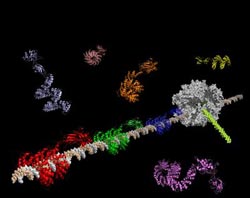Recreating natural complex gene regulation

This is an image of TALE.<br>Credit: Charles Gersbach<br>
This new approach should help basic scientists as they tease out the effects of “turning on” or “turning off” many different genes, as well as clinicians seeking to develop new gene-based therapies for human disease.
“We know that human genes are not just turned on or off, but can be activated to any level over a wide range. Current engineered systems use one protein to control the levels of gene activation,” said Charles Gersbach, assistant professor of biomedical engineering at Duke's Pratt School of Engineering and member of Duke's Institute for Genome Sciences and Policy. “However, we know that natural human genes are regulated by interactions between dozens of proteins that lead to diverse outcomes within a living system.
“In contrast to typical genetics studies that dissect natural gene networks in a top-down fashion, we developed a bottom-up approach, which allows us to artificially simulate these natural complex interactions between many proteins that regulate a single gene,” Gersbach said. “Additionally, this approach allowed us to turn on genes inside cells to levels that were not previously possible.”
The results of the Duke experiments, which were conducted by Pablo Perez-Pinera, a senior research scientist in Gersbach's laboratory, were published on-line in the journal Nature Methods. The research was supported by the National Institutes of Health, the National Science Foundation, The Hartwell Foundation, and the March of Dimes.
Human cells have about 20,000 genes which produce a multitude of proteins, many of which affect the actions of other genes. Being able to understand these interactions would greatly improve the ability of scientists in all areas of biomedical research. However because of the complexity of this natural system, synthetic biologists create simple gene networks to have precise control over each component. These scientists can use these networks for applications in biosensing, biocomputation, or regenerative medicine, or can use them as models to study the more complex natural systems.
“This new system can be a powerful new approach for probing the fundamental mechanisms of natural gene regulation that are currently poorly understood,” Perez-Pinera said. “In this way, we can further the capacity of synthetic biology and biological programming in mammalian systems.”
The latest discoveries were made possible by using a new technology for building synthetic proteins known as transcription activator-like effectors (TALEs), which are artificial enzymes that can be engineered to “bind” to almost any gene sequences. Since these TALEs can be easily produced, the researchers were able to make many of them to control specific genes.
“All biological systems depend on gene regulation,” Gersbach said. “The challenge facing bioengineering researchers is trying to synthetically recreate processes that occur in nature.”
Other members of the team were Duke's David Ousterout, Jonathan Brunger, Alicia Farin, Katherine Glass, Farshid Guilak, Gregory Crawford, and Alexander Hartemink.
Media Contact
More Information:
http://www.duke.eduAll latest news from the category: Life Sciences and Chemistry
Articles and reports from the Life Sciences and chemistry area deal with applied and basic research into modern biology, chemistry and human medicine.
Valuable information can be found on a range of life sciences fields including bacteriology, biochemistry, bionics, bioinformatics, biophysics, biotechnology, genetics, geobotany, human biology, marine biology, microbiology, molecular biology, cellular biology, zoology, bioinorganic chemistry, microchemistry and environmental chemistry.
Newest articles

Targeted use of enfortumab vedotin for the treatment of advanced urothelial carcinoma
New study identifies NECTIN4 amplification as a promising biomarker – Under the leadership of PD Dr. Niklas Klümper, Assistant Physician at the Department of Urology at the University Hospital Bonn…

A novel universal light-based technique
…to control valley polarization in bulk materials. An international team of researchers reports in Nature a new method that achieves valley polarization in centrosymmetric bulk materials in a non-material-specific way…

How evolution has optimised the magnetic sensor in birds
The magnetic sense of migratory birds is probably based on the protein cryptochrome 4, and a genetic study has now provided further support for this theory. A team of researchers…





















